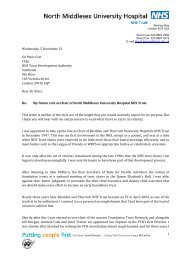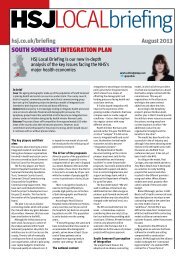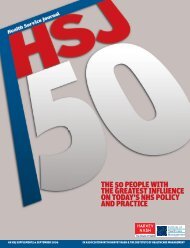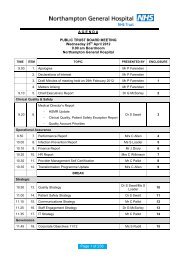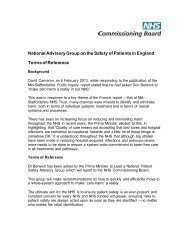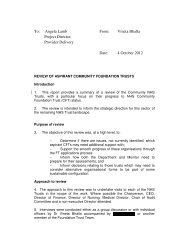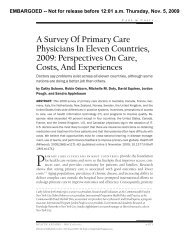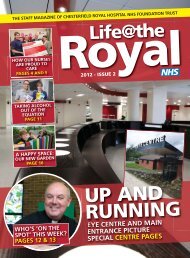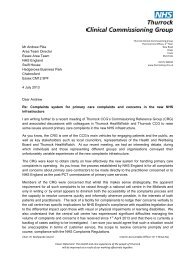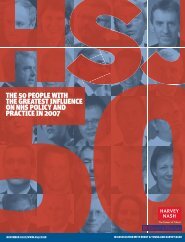HSJ Pathology Supplement - Health Service Journal
HSJ Pathology Supplement - Health Service Journal
HSJ Pathology Supplement - Health Service Journal
- No tags were found...
You also want an ePaper? Increase the reach of your titles
YUMPU automatically turns print PDFs into web optimized ePapers that Google loves.
Keeping up with the science (from left): Adrian Woolmore; Mike Sobanja; and RichardJones, who said pathology services would need to innovate in response to scientificadvances. Below: Peter Furness (top) and Adrian Newlandcould demonstrate that it was operating atan appropriate cost within a tax fundedmodel.”From a taxpayers’ perspective he said:“There is something about demonstratingcosts and, even more, a pathology servicethat is able to demonstrate its value in termsof the difference it makes to outcomes forpatients.”Personalised medicineRichard Jones said it was necessary toinclude something on innovation to the listof characteristics and highlighted the impactof molecular diagnostics, which opened upopportunities for pathology services thatorganisations needed to grasp. “We need totake advantage of scientific and medicaladvances,” he said.Professor Newland added thatpersonalised medicine would be important.An example of this was where testing coulddetermine which patients would benefitfrom new drugs so that money was notwasted treating those who would notrespond. “The problem we have inlaboratories is funding the introduction oftests that enable us to do that – to identifythe patients who can benefit from particulardrugs,” he said.Dr Prudo said there was a need to havepathology support for individuals. “We don’thave people trained in this kind of activity.It’s very doctor intensive.” Pathologistsmight have to pull together lots of differentinformation “We are going to require moreand more medical expertise to identify this.”Professor Furness called for decisionmakingbodies to say what should andshould not be used.“We can’t reasonably expect every singlelocal laboratory to be physically able to dothat job. It has to be more centralised. NICEis the obvious candidate for most of the stuffbut it is getting more complex.”Advice could extend to what is and isn’tworthwhile using in particularcircumstances. This could offer a way ofrelating the cost of tests to budgets – as itwould be clear that savings were made bynot doing things the patient would notbenefit from.“It is cheaper at the moment to do the testthan [to] argue about whether it is necessaryor not. We have to change that,” he addedProfessor Newland mentioned patientaccess to results, especially as where tests aredone diversifies – “the patient has to be incharge of that”.But while there was acknowledgementthat a diversity of providers is likely to beinvolved, Mr Jones pointed out some of theissues that held back the private sector. Hesaid: “There are issues around tariff andtransaction management, aroundprocurement rules and competition, and alsoaround TUPE and the impact on theworkforce of moving people around. Theyare massive issues preventing the marketplaying the part it can in this.”Jill Rodney said that people were vital tomaking change happen and they had notbeen talked about; clinical leadership wascrucial in all of this.Dr Prudo said there had been a lot ofdiscussion around cost but not what thebenchmarks for costs were. He highlightedthe very different costs between hospitals.Bringing the debate to an end, MrSobanja drew a series of key points out ofthe wide-ranging discussion. Theseincluded:l What do we mean by pathology? Was it anend-to-end service or simply a diagnostictesting service?l Variation was a critical issue. Reducingunwarranted variation is one of the mostproductive things we can do in the NHS, hesaid.l There is no “one size fits all” system.l Key performance indicators would beimportant for the service as wouldregulation/accreditation.l There was a distinction between the dataprocessing side of pathology services and thepathologist service – which raised questionsabout how they should be commissionedand whether different commissioningmechanisms were needed for these differentparts of the service.l 20-30 hubs for pathology services hadbeen proposed as a model with possibly amore “distributed” focus.l The role of the private sector would beimportant – “whoever can delivereffectively”.l Issues around workforce needs in thisnew world should not be forgotten. lwilde FRyhsj.co.uk3 November 2011 <strong>Health</strong> <strong>Service</strong> <strong>Journal</strong> supplement 7



